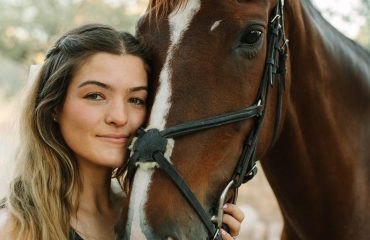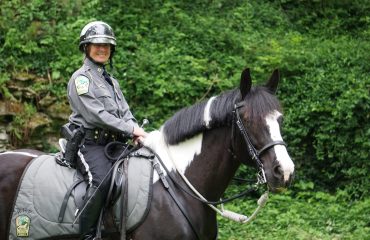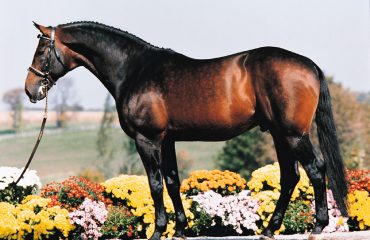
By Shya Beth
Ann Malphrus’ dive into the equestrian world may have started off like many animal-crazy children, but her path to becoming an equine artist took a different route than most. “I’ve always been drawn to working with my hands, and creating things has felt instinctive,” she said. “My dream of being an artist—more specifically, a horse sculptor—was born along with me; however, I travelled parallel paths that eventually led me back to my first love: sculpting.”
While Ann excelled in art and science in high school and attended horse shows with her white Connemara pony, Thunder, her interest in veterinary medicine was sparked by her time in the U.S. Pony Club. But the dream of pursuing art lingered. Not finding an appropriate path for pursuing art at college, Ann became a working student with Olympic eventer Jane Sleeper in Unionville, Pennsylvania, and Ann competed in eventing with her gray Connemara-Thoroughbred cross, Beau.

“Addiction”
Photo by Amy Randall
“Working in the barn, riding during the day and waiting tables at night sums up my days during that part of my life,” Ann said. “I admired the veterinarians from the University of Pennsylvania School of Veterinary Medicine’s New Bolton Center, and never missed a chance to watch them work their magic. After three years of hard work, my equestrian dream was shattered when Beau pulled up lame with a bowed tendon. Knowing the recovery would be long, I retreated to South Carolina to start over.”
Starting Over with Science
Ann was raised in Greenville, South Carolina, with parents that supported her interest in the natural world—as long as it could fit in a jar, initially. However, the jar was soon abandoned as hamsters, cats and dogs made their way into her family home. At age 6, Ann had her equestrian dreams fed in the school library by authors and illustrators Marguerite Henry, Wesley Dennis, CW Anderson and Sam Savitt.
“Through the goodness of my parents, my dream of owning a pony came true in the form of Stardust, a sturdy bay fellow with a broad back, a huge crest and a mane that never grew out,” Ann said. “We called him Dusty for short, and he was the first in a long line of ponies and horses that would enter my life. He will always be first in my heart, later becoming the inspiration for the name of my studio, Dusty Bronze Fine Art.”
After Ann’s riding dreams were crushed with Beau’s injury, her love of equine sculpting was still alive, which pushed her to attend the University of Georgia in 1979 with the intention of being an art major. However, she quickly figured out that ‘art major’ was not equivalent to ‘horse sculptor,’ which led to following her passion for horses differently in the academic world—becoming a veterinarian. Seven years later, in 1986, Ann graduated with honors from UGA’s College of Veterinary Medicine.
Even after embarking on her veterinary path, Ann didn’t follow the “horsey path” she pictured as a girl. “I worked in a large mixed-animal practice in Greenville for six years,” she said. “During that time, I had two daughters and realized that being out on emergency calls all night was too much of a hardship for my children. I decided to open my own small-animal practice, North Greenville Animal Hospital. Between running a small business and caring for a new family, it was 20 years until I chanced upon a horse sculpting class with sculptor Rod Zullo in 2013. He set me on the path to finally following that old dream of becoming a sculptor.”
Sculpting Old Dreams
Ann’s sculpting process is the same today as that she learned with Rod Zullo. First, she builds a wire and metal frame for the figure, called an armature, upon which she places softened oil-based clay. This clay never dries out, allowing her to work at her own pace, quickly or over a length of time. Using her hands as well as a variety of metal, wooden or silicon tools to sculpt the clay into the figure she envisions, Ann delivers the clay piece to an art foundry where the complex and ancient process of reproducing it using the lost-wax method of casting bronze takes place.

“Marshall”
Photo by Ann Malphrus
“The foundry begins their part of the work by making a rubber or silicon mold backed with a hard shell,” Ann explained. “Sadly, the original piece is destroyed in the mold-making process. The mold is then used to make wax models that are refined by people who specialize in wax ‘chasing.’ In the next stage, the wax models will be gradually encased in a sand/ceramic shell. Once hardened, it is heated and the wax flows out, leaving the empty ceramic shell into which molten bronze will be poured at nearly 2,000 degrees Fahrenheit.”
Once cooled, the shell is broken off to reveal the bronze replica of the original clay sculpture inside. That replica must be further refined by the “metal chasers” to remove seams and imperfections. In total, the work takes weeks to months to finish, and once it is completed, Ann returns to the foundry to check for defects and work with a patina artist who applies a variety of chemicals to the heated raw bronze to achieve the finish she has in mind.
“I only imagined I would ever have a shot at a career as an artist. Having recently sold my veterinary practice in 2019 and officially retired three years later in 2022, I feel that I am just now truly embarking on that bigger journey,” Ann said. “I’d like to create bas-relief work—a flat sculpture that bridges the gap between painting and 3-D sculpture—using resin casting. I’ve already begun exploring painting and mixed media techniques with the goal of producing a line of animal sympathy cards, which ties back to my prior life as a veterinarian.”
For more information, visit dustybronzefineart.com














